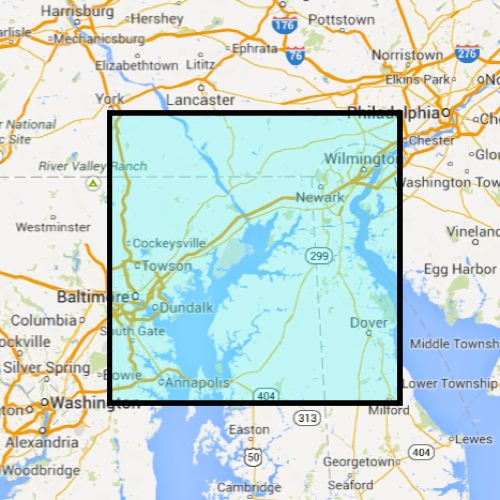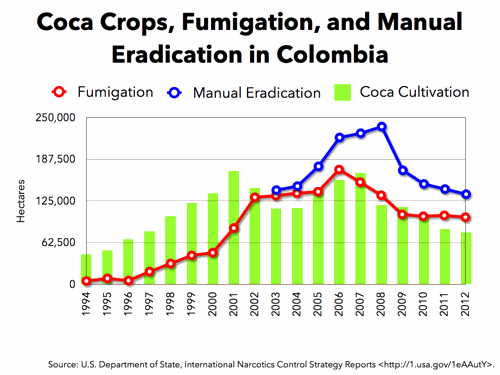Cultivation of coca, the plant used to make cocaine, has dropped steadily in Colombia since 2007. While the country’s coca plots totaled 167,000 hectares that year (a hectare equals about 2 1/2 acres), by 2012 the U.S. government measured 78,000 hectares. The UN Office of Drugs and Crime (UNODC) estimated [PDF] a similarly steep drop over those years, from 99,000 to 48,000 hectares. Colombia has returned to levels of coca-growing measured in the mid–1990s, and is no longer the world’s number one coca-producing country.
This is a remarkable shift, but it’s important not to learn the wrong lesson from it. In fact, a closer look makes evident that Colombia should abandon its aerial herbicide spraying, or “fumigation,” program—and ongoing peace talks with the country’s largest guerrilla group offer an excellent moment to do it. Fumigation has contributed only modestly to reduced coca growing: while the coca plots were disappearing since 2007, the use of fumigation was also dropping. The program, meanwhile, has proved costly to other conflict stabilization and governance goals.
This program has operated in Colombia, with heavy U.S. support, since 1994. Aircraft, mostly piloted by contractor personnel, fly over coca-growing zones spraying “Round-Up Ultra,” an herbicide including the active ingredient glyphosate, over about 100,000 hectares per year of Colombian territory. Between 1996 and 2012, aircraft have sprayed herbicides over 1.6 million hectares of Colombia—an area equivalent to a square 80 miles on each side. The corners of such a square would stretch from the Washington suburbs to the Philadelphia suburbs. That’s the equivalent of one hectare sprayed every 5 minutes and 29 seconds since January 1, 1996.

The amount of Colombian territory sprayed since 1996 would cover every square inch of this square.
Colombia is the only coca-producing country that fumigates its coca growers. Peru and Bolivia rely entirely on manual eradication: teams of paid personnel, usually members of the security forces, taken to coca-growing zones where they pull the plants out of the ground. Colombia carries out some manual eradication, but the work is extremely dangerous in a country where a nearly 50-year-old armed conflict persists; 62 coca eradicators have been killed and 387 injured since 2009, most of them the victims of guerrilla groups’ land mines, IEDs, and sniper attacks. The danger of eradication on the ground has been a principal justification for U.S. and Colombian governments’ choice to fumigate from the air.
Fumigation has been a factor in the past decade’s reductions in coca cultivation, as it makes it harder for coca growers to plant large single plots, which are easy targets for the spray planes. Still, notes the UN Office on Drugs and Crime’s latest report on Colombian coca cultivation [PDF], growers take many measures to minimize the damage.
Coca growers develop strategic behaviors to reduce the effect of aerial spraying on coca cultivations, such as interspersed or mixed sowing; applying substances to isolate the surface of the leaves from the effects of glyphosate; washing the leaves; increasing the amount of fields so that some of them will not be affected; rotating the plots in one productive unit and reducing the size of the fields, among others. Depending on the degree of impact, aerial spraying may cause the loss of one or more crops, reduction of the production or total loss. These impacts vary significantly from one region to the other, and it is clear that aerial spraying is not the only cause for the reduction or loss of crops.
While fumigation has contributed modestly to reduced coca growing, it has done so at a steep cost, both in dollars and in goodwill toward Colombia’s government in conflictive territories where it is most needed. The past twenty years’ experience makes clear that fumigation is neither an effective solution nor a model to follow in the future—especially if Colombia’s peace talks with guerrilla groups succeed and the country finds itself in a post-conflict context.
If their negotiating agenda reaches its fourth topic—drug policy—the Colombian government and the Revolutionary Armed Forces of Colombia (FARC) guerrilla group are likely to discuss the future of the fumigation program. Both sides should commit to bringing the fumigation program to an end, and to replacing it with voluntary manual eradication, as part of a larger effort to bring the civilian part of the government to long-neglected areas.
We call for an end to the fumigation program for three reasons.
- Fumigation only works on the margins, as a closer look at the data reveals.
“The available evidence almost definitively indicates that aerial spraying and manual eradication of illicit crops have been very costly and barely effective in reducing cocaine production,” writes Daniel Mejía [PDF], an economist who heads the Center for Studies on Security and Drugs at Bogotá’s University of the Andes. “For the United States, the marginal cost of reducing by one kilogram the amount of cocaine reaching its borders by attacking production is US$163,000, whereas the same result can be had attacking trafficking for US$3,600,” Mejía concludes [PDF].
A look at the cultivation numbers reveals two periods over the past ten years when coca-growing (the green bars in the graph below) dropped in Colombia. The first was after 2001, when “Plan Colombia” paid for a large increase in fumigation (the red line on the graph), bringing the program to new parts of the country. Fumigation played a role in this decrease—especially in the department of Putumayo where cultivation was at its most brazen—but so did the early 2002 failure of peace talks with the FARC guerrillas, which triggered a military offensive into a FARC-controlled area where much coca was grown.
Then, after 2003—despite the increased Plan Colombia fumigation—coca cultivation crept steadily back to 2001 levels (in U.S. measures) as coca cultivators adjusted to the inconveniences brought by the spraying. Frustrated by these results, the Colombian government began to increase its own manual eradication program (the blue line on the graph). Simultaneously, the U.S. government reduced funding for fumigation starting with the 2008 foreign aid appropriation, and the amount of land being fumigated declined.
It is after 2007 that Colombian coca cultivation began the steady decreases that continue today. But this has also been a period of reduced fumigation. The re
ductions of the post–2007 period owe much more to a stepped-up manual eradication program than they do to fumigation.
Manual eradication is more effective because it kills plants entirely. It also requires the government to be physically present on the ground in coca-growing areas, rather than flying anonymously overhead. Much manual eradication in the late 2000s occurred in the context of programs specifically designed to establish a more permanent government presence.
Manual eradication is no panacea, though. Carried out on its own, with no productive, food-security or other assistance to the local population, forced manual eradication can yield disastrous results for stability and governance. It is bad policy to set up an adversarial relationship with farming families in a territory where the government’s hold on territory is already tenuous.
To see the counter-productive nature of forced manual eradication, look no further than Bolivia, where in the late 1990s and early 2000s the government of Hugo Bánzer carried out the “Dignity Plan,” a mass campaign of U.S.-supported forced eradication in the remote Chapare region of Cochabamba department. The backlash against the Dignity Plan—including months of protests and clashes with eradicators and police—propelled to national prominence Evo Morales, the leader of the Chapare coca-growers’ union, who rode the ensuing wave of social-movement mobilization into Bolivia’s presidency. His government has since worked assiduously to reduce U.S. ties and influence in Bolivia, in a direct outcome of the forced eradication program that first gave President Morales a national political spotlight.
- Fumigation damages the government’s credibility.
In remote agricultural frontier zones and other poor rural communities where coca is planted, the only government presence that citizens see is either the occasional security force patrol or the fumigation plane that passes overhead. Fumigation removes, but does not add, choices for economic survival. It sets an adversarial relationship with the population, most of them farmer families, in zones where armed groups thrive and the government is already very weak.
Testimonies of health and environmental damage from fumigation have proliferated, but are hard to verify. Still, the damage to the government’s credibility is already done when the local population believes them to be true. And nearly everyone in affected zones can cite a case of legal food crops destroyed by spraying, forcing families to confront hunger.
A women’s pineapple-growing cooperative, hit hard by aerial fumigation in early 2013 (translation by Witness for Peace).
(Refresh page if not visible.)
The U.S. government chose not to carry out aerial herbicide fumigation of poppy in Afghanistan (though some eradicators on the ground did employ chemical herbicides). The Afghan government and many U.S. officials decided that aerial spraying would weaken the counterinsurgency effort, reduce support for the U.S.-allied Kabul government, and increase support for the Taliban. The New York Times reported in 2007 that “skeptics — who include American military and intelligence officials and European diplomats in Afghanistan — fear that any spraying of American-made chemicals over Afghan farms would be a boon to Taliban propagandists. Some of those officials say that the political cost could be especially high if the herbicide destroys food crops that farmers often plant alongside their poppies.”
Fumigation has had the same effect in Colombia. By giving illegal armed groups an opportunity to pose as the population’s protectors, it has essentially been an exercise in “counterinsurgency in reverse.”
In its post-conflict phase—if not before—Colombia’s government must make a new commitment to its remote, abandoned agricultural zones where guerrillas currently predominate and where fumigation is common. If people are to be allowed to live in an area, then the government’s response should be land titles, road networks, electricity, clean water, schools, health care, credit, and above all law enforcement and justice. Not fumigation.
- Fumigation shouldn’t be necessary in post-conflict Colombia.
If a successful peace process demobilizes Colombia’s guerrilla groups, the main justification for fumigation disappears. It will be safe enough on the ground to make eradication from the air unnecessary. Not only will manual eradicators presumably face no danger of guerrilla attack, the window should be open for establishing a genuine civilian state presence in long-neglected areas.
At the negotiating table in Havana, in exchange for Colombia’s government stopping the fumigation program, the FARC must commit to help get communities off of coca in the zones where they have been historically dominant—and to prevent new trafficking organizations’ entry into these zones.
With a disarmed FARC, the principal obstacle to a civilian state presence in long-abandoned areas of Colombia will disappear. Colombia’s government will then have to face an obstacle that could prove even more challenging: its own historic lack of political will to exercise its authority and provide basic services—especially justice—in most of its national territory.
Fumigation will never be able to substitute for that. It should be abandoned.


